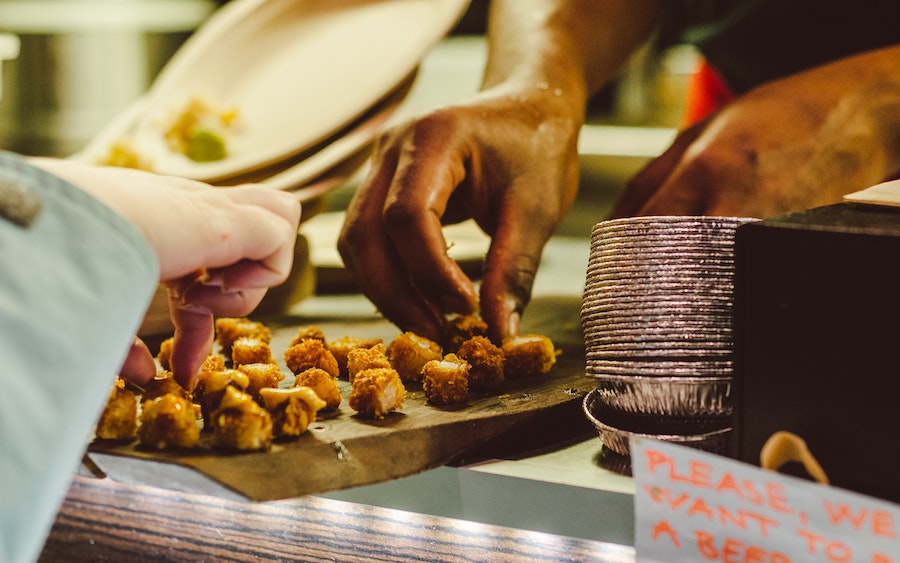The Evolution of Sampling Amid COVID-19
By Inspira Marketing
August 18, 2020
By Inspira Marketing
August 18, 2020
For those who have made the trek to the grocery store during the COVID-19 pandemic, it’s been quite the departure from the typical shopping experience. Masks and occupancy restrictions represent two of the most visible changes, but customers have also noticed the decided dearth of in-store samples available to try out while strolling through the aisles.
This is true outside of the grocery store, as well. Beauty store shoppers who enjoyed the ability to test out samples in the store are now flying blind when it comes to buying new products. Likewise, sampling is a core tactic of experiential marketing campaigns, and we, too, are working within the limitations brought by the pandemic. Below, we take a look at the role of sampling across industries and how brands are adapting to the changing landscape.

In-Store Sampling Meets Instacart
According to research from She Speaks, in-store sampling drives brand awareness (+57%), brand favorability (+63%), purchase intent (+48%), and recommendation intent (+55%). The reason that it works is rather simple; it mitigates the risk associated with buying an unfamiliar product. It clearly adds to the overall shopping experience, as well, with a Mintel survey indicating that 61% of U.S. adults would like to see more samples of new products while shopping for groceries.
However, the current reality is that CPG manufacturers have to find touchless workarounds. When Coca-Cola debuted Coca-Cola Energy in January, the initial plan was to execute an experiential sampling program to introduce the product to consumers. When the pandemic made such plans impossible, the brand leaned into the growth of online grocery purchases during the pandemic by inserting energy drink samples into online orders and donating product to hospitals and first responders. According to Advantage Solutions, which orchestrates a variety of in-store sampling services, the number of brands looking to capitalize on the same tactic as Coca-Cola has doubled in the last two months.
Beauty Sample Shipping
In recent years, beauty brands have gone all-in on the in-store experience with highly curated environments that foster discovery. However, if you’ve visited a store in recent months, you likely found it to be a more sterile experience. The lack of samples is one of the most glaring changes in beauty stores, and that’s an issue. According to Euromonitor International, samples are the third largest purchase driver for full-size products. Consequently, it’s anticipated that the minis market – which includes deluxe and travel-sized products – will grow in the interim.
To encourage full-sized purchases, The Harmonist has always offered free samples within Bergdorf Goodman, Neiman Marcus, and in their standalone boutiques. Historically, it has worked, with 60% percent of customers who take free samples converting to full-size products. So, when the pandemic struck, the brand pivoted and began selling individual fragrance samples online for only $6 – with cost accounting for production and shipping. Brands looking to take their sampling experience to the next level will have to think about the storytelling aspect, as well, and a virtual influencer event in conjunction with sample shipments could be the perfect opportunity to do just that.
Experiential Sampling from Afar
Sampling has always been a key tactic in experiential marketing efforts, and with the lack of in-person events this summer, brands are getting creative in terms of how they get their products in consumers’ hands. Last month, Kind launched a contest on its site in support of its new Kind Frozen bars. The reward for the three lucky winners? Their very own Kind Frozen bars delivered by either a trained bird, a drone, or a hot air balloon – a humorous spin on the ubiquity of deliveries at this time.
While Starburst didn’t have a new product to debut, the brand found a way to insert itself in the conversation around National Self-Care Day. Inspired by the popularity and viral memes about the pink Starburst flavor, Starburst created an all-pink self-care kit filled with a gratitude journal, succulent, yoga towel, jade roller, meditative coloring book, shower steamer, sleep mask, tumbler, and a heavy helping of pink Starbursts. The kits were priced at $0.99 and sold out immediately, but those who missed out were able to visit select retailers to buy special “all-pink” Starburst packs.
The inability to conduct in-person sampling has caused a ripple effect across industries, but brands are still finding creative ways to get product samples in consumers’ hands. If your brand is looking to design a creative sampling campaign, contact us today to learn how our suite of experiential marketing services can help you build awareness, encourage trial, and earn lifelong loyalists.
{{cta(‘61004bdb-f2f4-4c7f-b7ea-e57bed292904’)}}
Sources: “Retail Therapy: Starburst Goes All-In on Self-Care.” Retail Dive (2020), “Kind Deploys Birds, Drones, Hot Air Balloons to Send Out New Frozen Bars.” Marketing Dive (2020), “With In-Store Sampling on Hold, Brands Get Creative.” Adweek (2020), “What Will the Future of Beauty Sampling Look Like?” Glossy (2020), “In-Store Sampling Alternatives.” She Speaks (2020).